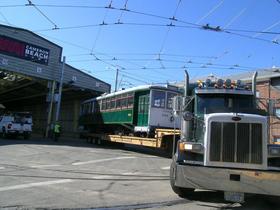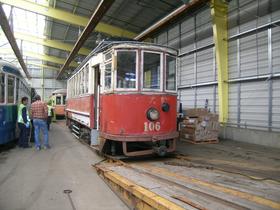Two vintage streetcars, one of them Market Street Railway’s highest restoration priority, are now safe from the elements after being moved this week to the new Cameron Beach Yard streetcar canopy.

1924 Market Street Railway Co. car No. 798, last of its kind, is backed into sheltered storage at Muni’s Cameron Beach Yard, November 1, 2011. Click on photo to enlarge.
Market Street Railway Company streetcar No. 798, hand-built in 1924 by San Francisco crafts workers just across the street in what were then the Elkton Shops of our namesake (then Muni’s privately owned competitor) rode the back of a tractor-trailer for the four-mile journey from our David L. Pharr Restoration Facility at Market and Duboce. The streetcar had been there for several years undergoing cosmetic restoration by our volunteers, led by Bill Wong and Don McKinsey (a story we’ll recount in the Winter edition of our member newsletter, Inside Track). That work is now done, with the next phase, including wiring, plumbing, and truck work, likely to be done by a contractor, so it was very important to get the streetcar under cover. It currently sits on non-powered “shop trucks” and while it might have been possible to tow it over the J-line, it was deemed prudent to keep it off the revenue tracks.
No. 798 is the sole survivor of 250 streetcars home built by Market Street Railway Co., providing hundreds of good blue-collar jobs to San Franciscans in the 1920s. Not only truly historic, it is also very large, with wide doors, giving it the high capacity needed for work on the F-line and future E-line.

1912 Moscow tram No. 106 being unloaded under cover at Cameron Beach Yard. Click on photo to enlarge.
This week’s move included a second vintage streetcar, 1912 vintage tram No. 106, which ran first in Moscow, then in the Soviet city of Orel. We know streetcars were used during the defense of Moscow in World War II to ferry supplies to the front and bring wounded back; it is possible that No. 106 played that role. It certainly had a long career ibefore being donated to San Francisco in 1987 by the Soviet Union for use on Market Street. However, between the donation and the completion of the permanent F-line, U.S. disability laws changed and door openings must be modified and other changes made before the car could possibly go into service. And in the intervening 25 years, the lack of covered storage (the Beach canopy was only completed 11 months ago) led to damage to wooden trams such as No. 106. MSR volunteer Peter McGowan spent many hours lovingly stripping old varnish from the car and restoring its roof and other portions of the body, but there remains a great deal of work to be done before the car could go into service. Because of its condition and smaller size, restoration of this tram is a lower priority, but at least it’s safe from further deterioration now.
Our ability to work towards completion of these two historic streetcars depends on support from our members and friends, since we receive no government funding for our restoration efforts. If you’re a member or a supporter of Market Street Railway, thank you! If not, please consider joining or donating. Thanks.
Thanks for the update on 798. The PCC shop trucks do look out of place, but Portland has replica vintage cars with PCC “works”. And even the big rig that brought the ex MSRy car to the Cameron Beach car house is a classic Peterbilt that would gain a thumbs-up from any truckers in the audience.
Any idea why the old Boeing LRV is being left to rot behind the Safeway? I’ve often wished that car would be restored and included in the current running F-market fleet. It brings back fond memories of my childhood growing up in SF. 🙂
Your post indicates that the Russian car doesn’t meet current ADA standards, but I thought that historic vehicles are exempt from ADA. The cable cars seem to be. Why is this causing problems with the Russian car? Is it a problem with other cars?
The cable cars (and the St. Charles streetcars in New Orleans) are categorically exempt from ADA requirements because 1) they are pre-existing, unchanged systems, and 2) they are National Historic Landmarks (the only two that move). Federal law (ADA) aside, it is Muni policy (which Market Street Railway supports) that the F-line streetcars be able to accommodate wheelchairs. Other vintage streetcars have had various modifications made for accessibility; there’s no structural problem in doing so with the Russian car, only money problems. Hope you’ll consider joining Market Street Railway.
They won’t be using PCC trucks under 798 in the restoration. We’d like to find some restorable vintage trucks of a type originally used under this class streetcar (there were several different ones). Failing that, either Melbourne or Milan trucks are possibilities, to help keep the fleet more standardized.
Muni management has not supported restoring any Boeings because they were so expensive and difficult to maintain while they were in service. Over the years, we’ve only heard a couple of voices raised for doing so. It’s actually easier to acquire parts for the PCC fleet than it would be for the Boeings, especially all the obsolete electronics.
As for the LRV fleet,
Out here in Boston, excluding the three work cars, we just recently cut up the remaining Boeing on property. It was a sad day.